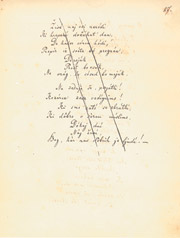The Path to Independence

Zdravljica, a toast to all
goodhearted people was
written in 1844
June 25, 1991 is a historic date for the Republic of Slovenia and all its citizens. It is when all political and cultural forces combined with the common aim of bringing to birth the Slovenian state, her recognition and further development.
On this day, the sovereign and independent Republic of Slovenia, a new country on the map of Europe and the world, was declared. The roots of the Slovenian state date back at least a century and a half, to 1848, during the turmoil of the Spring of Nations, when the idea of a sovereign state was first articulated, only to develop slowly at first, then gain impetus before and immediately after World War I, and emerge even more articulately during and after World War II, when it finally progressed towards partial and gradual realisation.

The awareness that Slovenes have the right to form a state had been building over a long period. Sometimes the process stalled, or even somewhat reversed, always in the light of current historical circumstances, which necessitated a particular decision or action. The awareness that, only by having an independent and sovereign state could the inhabitants of Slovenia participate in the development of the developed world as an equal partner, and take full responsibility for their future, matured in the 1980s. It led to the moment when a decision was inevitable ? the plebiscite at which an astonishingly convincing majority voted in favour of independence. In the following six months until independence was declared, the country focused on preparations, as it sought a peaceful, harmonious and consensual independence
The day when the independence of Slovenia was declared was thus a day of victory, a day when a nation independently entered history, and an act of great and justified national pride, which, however, was accompanied by a sense of insecurity, risk, and responsibility.
In the days, months and years which have followed, the history of the Slovenes has culminated, and in a mere fifteen years at least as much or even more has 'happened' than in the long decades beforehand. Only hours after independence the new-born country had to resist foreign aggression and defend herself both with military and diplomatic force, and convince both Europe and the world that it had a legitimate claim to sovereignty. In the following three months, Slovenia respected the compromise moratorium restraining her sovereignty, and reached an agreement with the former SFRY on the withdrawal of the its forces from Slovenian territory, which was concluded within four months; she then adopted her own constitution and introduced her own currency, and gradually also gained the necessary international recognition to become a full member of the United Nations and other international organisations in less than a year.
All these achievements provided the necessary international legal basis for even more important decisions on how Slovenia, in the midst of democratising her social and political system, and economic reform, could position herself in Europe and the world. Knowing that it was imperative to join contemporary development trends paved the way to joining the EU and NATO. These two objectives have been met, and now, the country is to adopt the euro and later also join the Schengen area. Today, Slovenia, as many other countries, including the most developed ones, faces comprehensive economic and social reforms, a challenge brought on by globalisation, and the ensuing development pace.
Even though after fifteen years the moment of deciding for independence and its declaration seem but a faint memory, the decisions and actions taken then have proven the key to succeeding events and developments. The citizens of Slovenia are aware of this, and their decisive choice, which has proved to be the right, sensible, and justified one, gives them courage and optimism to overcome and manage the obstacles they will face in the future.
More information:
- Path to Slovenian State (From the Plebiscite to Independence, War for Slovenia, Independence Documents, etc.)
